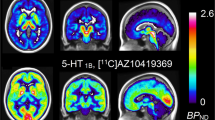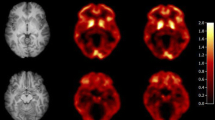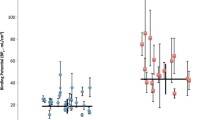Abstract
Purpose
[11C]AZ10419369 is a recently developed 5-HT1B receptor radioligand that is sensitive to changes in endogenous serotonin concentrations in the primate brain. Thus, [11C] AZ10419369 may serve as a useful tool in clinical studies of the pathophysiology and pharmacological treatment of diseases related to the serotonin system, such as depression and anxiety disorders. The aim of this study was to evaluate the test–retest reliability of [11C]AZ10419369.
Methods
Eight men were examined with PET and [11C] AZ10419369 twice on the same day. The binding potentials (BPND) of [11C]AZ10419369 in selected serotonergic projection areas and in the raphe nuclei (RN) were determined using the simplified reference tissue model, and for comparison also using a wavelet-aided parametric imaging approach. The BPND values obtained from the first and second PET scans were compared by means of descriptive statistics, difference, absolute variability and intraclass correlation coefficient.
Results
Similar BPND values were obtained with the two methods. The absolute mean differences in BPND between PET 1 and PET 2 were less than 3 % in all serotonergic projection regions. Absolute variabilities were low in cortical regions (5 – 7 %), low to moderate (7 – 14 %) in subcortical regions, but higher (20 %) in the RN.
Conclusion
The BPND of [11C]AZ10419369 is highly reproducible in cortical regions and satisfactory in subcortical projection areas. The variability in the RN is higher. Thus larger sample sizes or larger divergences are required to assess a potential difference between subjects or between experimental conditions in this region.



Similar content being viewed by others
References
Sari Y. Serotonin1B receptors: from protein to physiological function and behavior. Neurosci Biobehav Rev. 2004;28:565–82.
Ruf BM, Bhagwagar Z. The 5-HT1B receptor: a novel target for the pathophysiology of depression. Curr Drug Targets. 2009;10:1118–38.
Nicholson SL, Brotchie JM. 5-hydroxytryptamine (5-HT, serotonin) and Parkinson’s disease – opportunities for novel therapeutics to reduce the problems of levodopa therapy. Eur J Neurol. 2002;9 Suppl 3:1–6.
Varnas K, Jucaite A, McCarthy DJ, Stenkrona P, Nord M, Halldin C, et al. A PET study with [11C]AZ10419369 to determine brain 5-HT1B receptor occupancy of zolmitriptan in healthy male volunteers. Cephalalgia. 2013;33:853–60.
Varnas K, Hall H, Bonaventure P, Sedvall G. Autoradiographic mapping of 5-HT(1B) and 5-HT(1D) receptors in the post mortem human brain using [3H]GR 125743. Brain Res. 2001;915:47–57.
Varnas K, Hurd YL, Hall H. Regional expression of 5-HT1B receptor mRNA in the human brain. Synapse. 2005;56:21–8.
Adell A, Celada P, Artigas F. The role of 5-HT1B receptors in the regulation of serotonin cell firing and release in the rat brain. J Neurochem. 2001;79:172–82.
Varnas K, Nyberg S, Halldin C, Varrone A, Takano A, Karlsson P, et al. Quantitative analysis of [11C]AZ10419369 binding to 5-HT1B receptors in human brain. J Cereb Blood Flow Metab. 2011;31:113–23.
Pierson ME, Andersson J, Nyberg S, McCarthy DJ, Finnema SJ, Varnas K, et al. [11C]AZ10419369: a selective 5-HT1B receptor radioligand suitable for positron emission tomography (PET). Characterization in the primate brain. Neuroimage. 2008;41:1075–85.
Andersson JD, Pierson ME, Finnema SJ, Gulyas B, Heys R, Elmore CS, et al. Development of a PET radioligand for the central 5-HT1B receptor: radiosynthesis and characterization in cynomolgus monkeys of eight radiolabeled compounds. Nucl Med Biol. 2011;38:261–72.
Finnema SJ, Varrone A, Hwang TJ, Gulyas B, Pierson ME, Halldin C, et al. Fenfluramine-induced serotonin release decreases [11C]AZ10419369 binding to 5-HT(1B)-receptors in the primate brain. Synapse. 2010;64:573–7.
Nord M, Finnema SJ, Halldin C, Farde L. Effect of a single dose of escitalopram on serotonin concentration in the non-human and human primate brain. Int J Neuropsychopharmacol. 2013;16:1577–86.
Finnema SJ, Varrone A, Hwang TJ, Halldin C, Farde L. Confirmation of fenfluramine effect on 5-HT(1B) receptor binding of [11C]AZ10419369 using an equilibrium approach. J Cereb Blood Flow Metab. 2012;32:685–95.
Sheehan DV, Lecrubier Y, Sheehan KH, Amorim P, Janavs J, Weiller E, et al. The Mini-International Neuropsychiatric Interview (M.I.N.I.): the development and validation of a structured diagnostic psychiatric interview for DSM-IV and ICD-10. J Clin Psychiatry. 1998;20(59 Suppl):22–33; quiz 4–57.
Derry C, Benjamin C, Bladin P, le Bars D, Tochon-Danguy H, Berkovic SF, et al. Increased serotonin receptor availability in human sleep: evidence from an [18F]MPPF PET study in narcolepsy. Neuroimage. 2006;30:341–8.
Varrone A, Sjoholm N, Eriksson L, Gulyas B, Halldin C, Farde L. Advancement in PET quantification using 3D-OP-OSEM point spread function reconstruction with the HRRT. Eur J Nucl Med Mol Imaging. 2009;36:1639–50.
Schain M, Toth M, Cselenyi Z, Stenkrona P, Halldin C, Farde L, et al. Quantification of serotonin transporter availability with [11C] MADAM – a comparison between the ECAT HRRT and HR systems. Neuroimage. 2012;60:800–7.
Bonaventure P, Schotte A, Cras P, Leysen JE. Autoradiographic mapping of 5-HT1B- and 5-HT1D receptors in human brain using [3H]alniditan, a new radioligand. Receptors Channels. 1997;5:225–30.
Innis RB, Cunningham VJ, Delforge J, Fujita M, Gjedde A, Gunn RN, et al. Consensus nomenclature for in vivo imaging of reversibly binding radioligands. J Cereb Blood Flow Metab. 2007;27:1533–9.
Cselenyi Z, Olsson H, Farde L, Gulyas B. Wavelet-aided parametric mapping of cerebral dopamine D2 receptors using the high affinity PET radioligand [11C]FLB 457. Neuroimage. 2002;17:47–60.
McGraw KO, Wong SP. Forming inferences about some intraclass correlation coefficients. Psychol Methods. 1996;1:30–46.
Shrout PE, Fleiss JL. Intraclass correlations: uses in assessing rater reliability. Psychol Bull. 1979;86:420–8.
Alakurtti K, Aalto S, Johansson JJ, Nagren K, Tuokkola T, Oikonen V, et al. Reproducibility of striatal and thalamic dopamine D2 receptor binding using [11C]raclopride with high-resolution positron emission tomography. J Cereb Blood Flow Metab. 2011;31:155–65.
Lundberg J, Halldin C, Farde L. Measurement of serotonin transporter binding with PET and [11C]MADAM: a test-retest reproducibility study. Synapse. 2006;60:256–63.
Hirvonen J, Kajander J, Allonen T, Oikonen V, Nagren K, Hietala J. Measurement of serotonin 5-HT1A receptor binding using positron emission tomography and [carbonyl-(11)C]WAY-100635 – considerations on the validity of cerebellum as a reference region. J Cereb Blood Flow Metab. 2007;27:185–95.
Jovanovic H, Cerin A, Karlsson P, Lundberg J, Halldin C, Nordstrom AL. A PET study of 5-HT1A receptors at different phases of the menstrual cycle in women with premenstrual dysphoria. Psychiatry Res. 2006;148:185–93.
Paterson LM, Kornum BR, Nutt DJ, Pike VW, Knudsen GM. 5-HT radioligands for human brain imaging with PET and SPECT. Med Res Rev. 2013;33:54–111.
Selvaraj S, Turkheimer F, Rosso L, Faulkner P, Mouchlianitis E, Roiser JP, et al. Measuring endogenous changes in serotonergic neurotransmission in humans: a [11C]CUMI-101 PET challenge study. Mol Psychiatry. 2012;17:1254–60.
Acknowledgments
We thank Katarina Varnäs for her generous help in calculating the ICCs. We also thank the other members of the PET group at the Karolinska Institutet for their close assistance during this study.
Conflicts of interest
L.F. is an employee of AstraZeneca and affiliated with KI. C.H. has a consultancy agreement with AstraZeneca. M.N., S.F. and M.S. declare no conflicts of interest. The research leading to these results also received support from the Swedish Research Council under grant K2012-61X-09114-23-4 to L.F. and from the Innovative Medicine Initiative Joint Undertaking under grant agreement n° 115008 of which resources are composed of EFPIA in‐kind contribution and financial contribution from the European Union's Seventh Framework Programme (FP7/2007‐2013).
Author information
Authors and Affiliations
Corresponding author
Rights and permissions
About this article
Cite this article
Nord, M., Finnema, S.J., Schain, M. et al. Test–retest reliability of [11C]AZ10419369 binding to 5-HT1B receptors in human brain. Eur J Nucl Med Mol Imaging 41, 301–307 (2014). https://doi.org/10.1007/s00259-013-2529-1
Received:
Accepted:
Published:
Issue Date:
DOI: https://doi.org/10.1007/s00259-013-2529-1




